Longstreet Attacks: The Second Day at Gettysburg
By Claude Whalen:
After a few sessions of “Dan Stays Put (sort of)”, I played one final session of this “What If” scenario. The scenario can last 14 turns (just like the “Hammerin Sickles” historical scenario) but usually, the game is decided rather quickly. Either the CSA forces are quickly successful in their quest or things go terribly wrong and Longstreet decides that he has to call off the attack. In all of my plays of this scenario, one game lasted only four turns (CSA victory) or (more likely) the game goes to about turns #9 or #10 and Longstreet calls his men back. This game turned out to be the longest of all my plays, mainly because of the mid-stream change in strategy by Longstreet. In the end, this turned out to be the most entertaining play of them all.
There are various ways for the CSA to play this scenario. Some Confederate strategies are obvious but one less obvious strategy gives them their best chance to win. Part of the fun is finding out how to outwit the Union forces so I really don’t want to give the strategy away. As for time to play this scenario, it clearly can vary depending on what the CSA does…
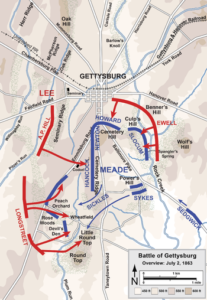
Overview map of the actual second day of the Battle of Gettysburg, July 2, 1863. Click to enlarge. – Wiki
25 men have staggered into the field northeast of Taneytown Road. There they rally around the regimental flag of the 6th NJ. Some men are slightly wounded, some are out of ammo, some are in shock, all of them are scared. It is 7:40 pm, it is getting dark and smoke covers the field. Some shadowy figures appear, it must be help. Wait, it is a man on a horse, his shirt is bloodied, it is… it is…General Barksdale with 500 men of the 13th MS. Outnumbered 20—1, the men of the 6th NJ face their fate and wonder how they got there.
Earlier in the day, Hood (for the 15th time) asks Longstreet for permission to “go around to the right.” Like any parent on a long car trip, Longstreet broke and let Hood (and us) go off on his excellent adventure.
The Rebels got off to a decent start with all of Hood’s Brigades moving except for Anderson whose move was canceled by the “Fog of War” chit. In turn #2 though, Hood was wounded by the “Fog of War” chit and the adventure is not so excellent anymore. With Hood’s replacement’s lower Command Rating, Anderson again fails his activation and now he was way behind the rest of his Division. Law’s Brigade keeps racing around the Round Tops anyway. Sickles, being Sickles, had a limited reaction to the reports of CSA troops moving south of him and so his response was slow. When Sickles failed his Command Roll, in turn #2, Law managed to squeeze three regiments through the ragged Union emergency defense line. Union Opportunity Fire did manage to force two of Law’s regiments back two hexes. Now Hood’s Division was really starting to string out and if anything else in Hood’s original plan failed, disaster looms. On turn #3, everything fell apart for Hood’s boys.
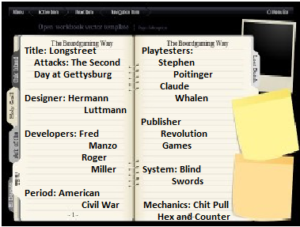 Hood’s replacement made all of his command rolls but fate finally caught up with him. The Union used a “Command Confusion” chit and managed to blow up Hood’s plan. Hood had given strict orders but when he went down, his men lost control, fired on the Union forces, alerted Sickles to the attack and triggered a huge response from the AoP. Law tried to move his lagging men past the emergency Union line but the “Command Confusion” chit turned his “maneuver” order into an “attack” directive. Disastrously, this unfroze the entire AoP (except Hays and Gibbon) on the southern portion of the battlefield.
Hood’s replacement made all of his command rolls but fate finally caught up with him. The Union used a “Command Confusion” chit and managed to blow up Hood’s plan. Hood had given strict orders but when he went down, his men lost control, fired on the Union forces, alerted Sickles to the attack and triggered a huge response from the AoP. Law tried to move his lagging men past the emergency Union line but the “Command Confusion” chit turned his “maneuver” order into an “attack” directive. Disastrously, this unfroze the entire AoP (except Hays and Gibbon) on the southern portion of the battlefield.
Now that the Union can react and counter-attack the clear CSA attempt to flank them. Vincent formed a second, stronger line in front of Law, and Day’s brigade came up in support of him. But Day is not fast enough and Law chewed up Vincent’s men before considering a retreat. Brewster had also activated his men and splits his brigade, some men moved to Law’s west and others went south of Law. Splitting up a brigade is a bad move though and Law pushes Brewster out of the way rather easily as Law heads back towards the supporting Hood brigades. Detrobriand gets onto Taneytown Road and his troops set up to block Benning from coming to Law’s assistance. Robertson was even further behind Law and no AoP troops can really even see him coming. Things look very desperate for Hood’s men as the division can now be defeated piecemeal. They had started to consolidate the division but they need help, which they got on the very first chit pull of Turn #4.
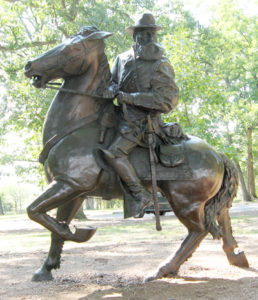
“Old Pete” Longstreet’s statue at Gettysburg. The effort it took to get this statue anywhere near Gettysburg is worth an article all its own. – Fred
Since Hood badgered Longstreet into getting his way, the entire “en echelon” plan went out the window. Now Barksdale used the same approach on McLaws and by 4 pm, all of McLaws division has been inching forward. They didn’t attack but they got into a better position to hammer Sickles’ troop placements. They were ready to strike the Peach Orchard and Stony Hill at any moment. Anderson’s division also was ready to move but only as a last-ditch effort to draw off troops and give Hood a chance to escape. It sure looked like the ANV was spread all over the map and now it would become a battle to save themselves.
This is the “Blind Swords” system though and as previously stated, the first chit pull of Turn #4 was a huge reversal of fortune. The “Fog of War” chit came out, and on a chance of under 3%, Hood returned to the battle! His return gave his forces an even better chance to maneuver and rally and they sure needed it.
With this help, Turns #4 and #5 allowed a combination of the Longstreet/Hood/Brigade Reserve Movement chits to bring up BOTH Benning and Robertson to join Law as he defended high ground on Taneytown Road. McLaws unleashed his men and Semmes ambushed Carr, which broke one unit, eliminated another and caused another two units to panic. Carr’s ability to fight was finished for the game. Barksdale manhandled Kelly and now Sickles had to split his very limited abilities to two different fronts.
Sickles is a good politician but a bad General, which means that he failed his Command Roll in Turn #6. Kershaw took advantage of that and pounded the AoP center. His initial fire broke two units and depleted another. Kershaw then charged Ward, breaking another two regiments and sending a third unit fleeing in panic. Carr, who had lost his ability to fight effectively, had to attack anyway because he was the only guy in the area. His low combat rolls spelled defeat and now he was reduced to one regiment. Law/Benning/Robertson continue to hold their defensive position!
Turn #7 and Sickles still stunk as a leader (having Dan survive deep into the battle is the CSA’s secret weapon). Sickles mismanaged Day’s approach (a regroup order for a fresh brigade) and Hood’s men continued to fire on the weakened AoP line that was supposed to be attacking them. After watching Carr evaporate, these other Union regiments are not moving forward. As Sickles wasted his time with Day, Kershaw was free to rampage in the Union center. Two more AoP regiments are depleted and Sickles needed to attend to that crisis.
Turn #8, Anderson (the missing brigade of Hood’s division) finally showed up but not behind the rest of the division. No, Anderson had come up the front of Houck’s Ridge, eliminated Smith’s batteries in the Valley of Death and then advanced towards the western slope of LRT. Longstreet and McLaws combined to rally most of Kershaw’s brigade and CSA hopes started to pick up. Sickles/Birney/Humphries/Barnes took a break from their leadership duties and none of their men moved. “Well heck, if they wouldn’t fight, I will,” said Barksdale and he hit Burling and Cross. His attack broke one unit and depleted two others.
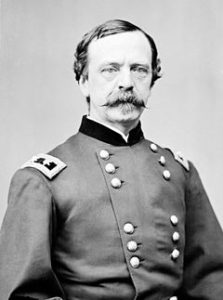
“Uncle” Dan Sickles was charged with the murder of Francis Scott Keys’ son in 1859. Sickles’ “Dream Team” of lawyers included Edwin M. Stanton, (soon to be Lincoln’s Secretary of War) and his successful plea of “temporary insanity” was the first time this defense was used in the United States. – Fred
Turn #9 and Sickles actually made his command roll. Unfortunately, Barnes/Briney/Humphries still continued to flail helplessly and their men ate dinner. Eight out of nine “close combats” for the turn came from the CSA. Though two ANV units were depleted, they just hammered the AoP during this turn. The Union had one unit eliminated, four broken, four panic and five depleted.
The Union had plenty of men but at this rate, even U.S. Grant would start to worry about casualties. Longstreet started to shift from defense to offense and Lee had stopped thinking about how to word his resignation. You could almost hear Hancock pleading with Meade, “put me in coach”. But Meade was made of stronger stuff, refused to break under the nagging and kept Sickles in command.
Hood’s boys were able to form strong line east of Little Round Top with its left anchored on Taneytown Road. There they fought some (and pinned down all) of the following Union Brigades: Vincent (shattered by the fighting) Day and Brewster (roughly handled but not shattered) Weed and Tilton held back in support (in Tilton’s case, way back) and never made it to the front lines. Ward and Detrobriand’s battle-worn regiments held onto Little Round Top but the slow but steady arrival of Anderson’s Brigade swept them off the hill (both of these brigades were also shattered).
It did cost Hood’s men dearly though:
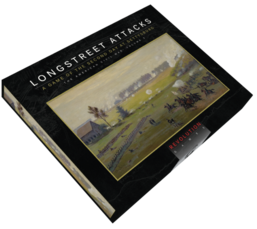
“Longstreet Attacks: the Second Day at Gettysburg” is the fourth game in the “Blind Swords” series. It will be released by Revolution Games sometime later this month or in June. The other three games in the series are “Stonewall’s Sword: the Battle of Cedar Mountain,” “Thunder in the Ozarks: the Battle of Pea Ridge” and the GMT game “At Any Cost: Metz 1870.”
By 7:40 pm, Law still had 3 fresh regiments and two battle-worn ones. Robertson took harder pounding and so he had 2 fresh units and 2 battle-worn ones. Benning had 2 fresh units, 1 battle-worn one, and 1 broken unit. Anderson came late to the party and hit crippled Union units so he only had 1 shaken unit. Hood‘s men did yeoman’s work in saving themselves, they rallied strongly and really saved Longstreet from disaster on his far right flank. Kershaw eventually moved up on Anderson’s left flank and formed an effective block against quick Union move to the center of the battlefield.
Over on the Northwest portion of the battlefield, things were not going as well for the CSA. The Codori Farm area was the focal point of what amounted to a bloody stalemate. Wofford’s troops slid over to help Anderson’s Division but they too got sucked into the standoff. Though some CSA brigades were able to retreat and rally themselves (Wilcox, Wright, and Lang), they rapidly became battle-worn again soon after they re-entered the fight.
As of 7:40 pm, the CSA losses in this portion of the field were as follows:
Wofford had only 2 fresh units left, Wilcox and Wright had 1 fresh unit apiece, Lang had 2 fresh units but only 9 strength points between them, and Posey had 3 battle-worn units and 1 unit on the broken track. The only good thing about this fight was that it tied up the following AoP brigades: Willard, Smyth, Hall, Harrow, Brooke, Kelly and Sweitzer.
That left the center of the Union line. Since Wofford went over to help Anderson and Kershaw veered off to help Hood (shattering Carr and Burling in the process), that left Barksdale and Semmes to face Burbank, Webb, Cross, Zook and few battle-worn units of Graham, Ward and two regiments of Burling.
Let us focus on these 2 CSA Brigades as they fight in turns #10 thru #12.
Turn #10:
Barksdale opens the turn by attacking Cross and breaking the 815th PA. He also attacks the 6th NJ and inflicts “D/2M/RA2” result on them. The 6th NJ flees behind Taneytown Road and starts looking for their flag. Barksdale also gets “Morale hit and retreat 2 hexes” on Sheldon’s guns, which causes the 66th NY to panic.
Turn #11:
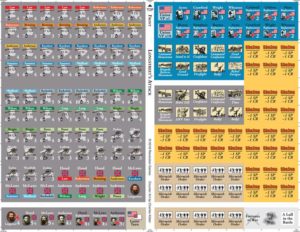 Webb’s battle-worn units attack Barksdale. Defensive fire depletes the 72nd PA and a bad close combat result depletes the 71st PA; Webb has failed. Barksdale returns the favor and counter-attacks Webb. The CSA forces also hit the depleted batteries of Ames and Clark. “D2/RA1” means goodbye to those guns as they are eliminated from the game. Webb and Zook had battle-worn units next to those now eliminated guns. Barksdale’s initial fire broke the 115th PA and 5th NJ. Close combat broke the 71st PA and eliminates the 52nd NY. Longstreet is the next chit pulled, he activated Barksdale again and the Union must do something to slow him down. “Command Confusion” chit was played and only one roll can cause that chit to fail. Disaster strikes as “4” was rolled and Barksdale’s attack was allowed to continue. Barksdale’s initial fire depletes Phillips guns but finally, something happens that slows Barksdale down. Defensive fire causes an “M/RZ” result on the 17th MS.
Webb’s battle-worn units attack Barksdale. Defensive fire depletes the 72nd PA and a bad close combat result depletes the 71st PA; Webb has failed. Barksdale returns the favor and counter-attacks Webb. The CSA forces also hit the depleted batteries of Ames and Clark. “D2/RA1” means goodbye to those guns as they are eliminated from the game. Webb and Zook had battle-worn units next to those now eliminated guns. Barksdale’s initial fire broke the 115th PA and 5th NJ. Close combat broke the 71st PA and eliminates the 52nd NY. Longstreet is the next chit pulled, he activated Barksdale again and the Union must do something to slow him down. “Command Confusion” chit was played and only one roll can cause that chit to fail. Disaster strikes as “4” was rolled and Barksdale’s attack was allowed to continue. Barksdale’s initial fire depletes Phillips guns but finally, something happens that slows Barksdale down. Defensive fire causes an “M/RZ” result on the 17th MS.
In close combat though, Barksdale’s other units press onwards, the 18th MS takes depletion result but Phillips guns are eliminated and the 8th NJ was broken. As this was going on, Semmes rallies the 53rd GA and prepares to join the fight.
Nevin heard the call to “stop the Rebels” and he threw his brigade at Barksdale. Barksdale was still pretty strong though and defensive fire depleted the 98th PA. Nevin close combat was a festival of low rolls and so the 139th PA and then the 93rd PA were depleted. They still blocked Barksdale’s way north and routing them will slow the Rebs down. Nevertheless, the 13th MS has made it to Hex #2607 (Taneytown Road).
Turn #12:
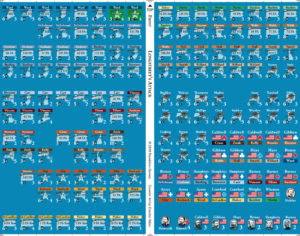 The “Lull” chit is in the game now so artillery is rather ineffective (a 2 column shift downwards in strength) and the turn ends whenever this chit is pulled.
The “Lull” chit is in the game now so artillery is rather ineffective (a 2 column shift downwards in strength) and the turn ends whenever this chit is pulled.
Nevin starts off the fighting and he once again charged Barksdale. Though he didn’t deplete or break anybody, he still forced the 13th MS back 2 hexes. Semmes then joined the fighting and though both the 10th and 51st GA were depleted, the Union paid dearly. Ward lost his 1st US Sharpshooters-b to the broken track.
Webb lost the 72nd PA and 66th NY broke. Since everyone else is breaking, the 57th NY joins in the fun and breaks (actually Semmes did it).
Longstreet activates Barksdale and tells him to “finish them”. Nevin bears the brunt of Barksdale’s forces and initial fire breaks the 139th PA. Close combat ensues with the 98th PA breaking, the 62nd NY being depleted and the 5th NH and 93rd PA panicking. There is now a large hole in the Union line and even Sickles can see that it is a crisis (Sickles needs to be hit for Hancock to become “magnificent.” When Dan dodges bullets, the CSA is happy and they are happy right now.)
Burbank was off to Barksdale’s right flank and he sent his men to staunch the bleeding. Defensive fire broke the 17th US but the shock of this attack was too much for Barksdale’s men. Both the 10th GA and 21st MS panicked (uh—oh) and even worse, the 17th and 18th MS broke.
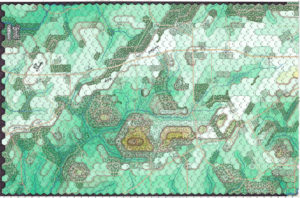
This is the southern half of the Gettysburg battlefield. North is to the right, West to the top and East to the bottom. Big Round Top (BRT) is to the lower left and Little Round Top (LRT) is to its immediate right. “The Peach Orchard Crossroads” is toward the top center and “The Wheatfield” is almost dead centered. Note: This is a draft map, though it will not be terribly different from the final map. (Click to enlarge.)
The 13th MS was now all alone. Burbank was to its south so they were cut off from their supporting units. Fisher was little further to the east but hopefully Kershaw’s presence to the south will freeze him in place. A strong Union gun line was to the west of the 13th MS (though all those guns faced southwest).
It is the 10th chit pull of the turn and McLaws comes out of the cup. McLaws makes his command roll and issued orders. Since the 13th MS is “The ‘Little’ Regiment That Could,” they took the orders and (what else) head north!
They first fired on the battle-worn 62nd NY and broke it. A path was now open and Barksdale looked around. Heading straight north, he will eventually run into more Union brigades (Tilton was up there twiddling his thumbs) or he could head west. There is only one lonely unit to his west and that is the battle-worn, disrupted remnants of the 6th NJ (the guys Barksdale had beat up in turn #10). 25 men huddled around their regimental flag with no real firepower. If Barksdale moves around them, they can fire on him but only with “Cadre” strength. He can then charge Turnbull‘s guns at the Hummerbach Farm (the “Lull” chit weakens artillery so this isn’t guaranteed suicide mission for one unit). So Barksdale leads the way and soon the 6th NJ gets to see the apparition of the 13th MS looming out of the darkness. As it turns out, Barksdale didn’t care about them, his men were intent on taking those Union guns from the rear. So the 25 terrified men of the 6th NJ are ignored and get to live to fight another day.
Though wounded 5 times (all flesh wounds, he isn’t Hood), Barksdale leads his men in a run around the 6th NJ (no zones of control to stop them). With only 25 men shooting, the 6th NJ cannot stop Barksdale with opportunity fire and so the 13th MS fell upon Turnbull’s guns. Turnbull got a defensive fire roll of “14,” which means that a couple of gunners fired pistols at Barksdale’s boys and, of course, the charge was not stopped. At “3-2” odds, +1 bonus for higher morale and +4 bonus for attacking guns, the 13th MS gets to fight on the highest combat column. They roll “54” which means “severe” result and then get “Deplete All/Retreat All 1.” Barksdale takes the J. Hummerbach Farm (automatic victory hex).
There are 6 Union batteries within two hexes of the 13th MS but he has gotten in behind them. If they pul out, the AoP center may completely panic. Now for the hard part, the 13th MS is still alone and they have to hold their position until the end of the turn to get the automatic victory. Yet they are “The ‘Little’ Regiment That Could” and the next chit pull out of the cup is the “Lull” chit.
Turn over, game over, Minor CSA Victory, see you at Pipe Creek!
What happened here? Hood’s men were cut off and Hood was down, they should have been destroyed in detail. Well, Hood came back on the next turn (a 2.78% chance of happening per turn) and he was able to whip his boys into line and then rally them as needed. Their stronger morale allowed them to hold their positions, rotate battle-worn units out of line and then rally them. They also sucked a large amount of Union troops over to the wrong side of Cemetery Ridge. On the other side of the battlefield, Anderson’s men were not as successful. They had a harder time rallying their troops but they still held down a large number of Union troops. That meant that the Union center was actually rather weak. Yes, there were only two CSA brigades there but one of them was Barksdale and that made all the difference.
In sense, this turned out to be like Lee‘s plan for July 3rd. The Union wings are strong so their center must be weak. It shouldn’t have worked for Longstreet but luck (and “The ‘Little’ Regiment That Could“) was on his side.
Lee does NOT resign. Longstreet does NOT say naughty things about Robert. Longstreet gets included on Stone Mountain. Meade shoots Sickles and demands a re-match.
Set up the ”What If” scenario again boys ……
Game Resources:
 Longstreet Attacks: The Second Day at Gettysburg BGG page
Longstreet Attacks: The Second Day at Gettysburg BGG page
Longstreet Attacks: The Second Day at Gettysburg Home Page
(Note: “Longstreet Attacks: The Second Day at Gettysburg” will be published by Revolution Games sometime in June 2018. It was originally named “Hammerin’ Sickles” when it was on the GMT P500 list. – Fred)


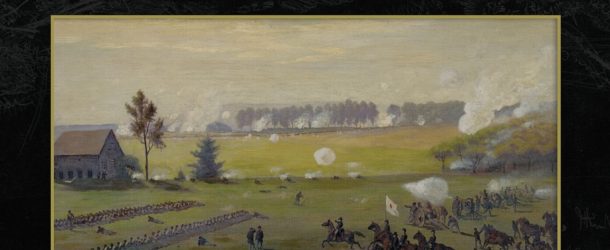
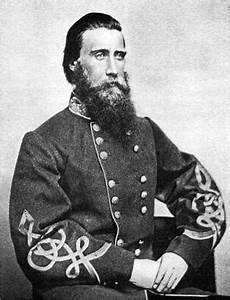
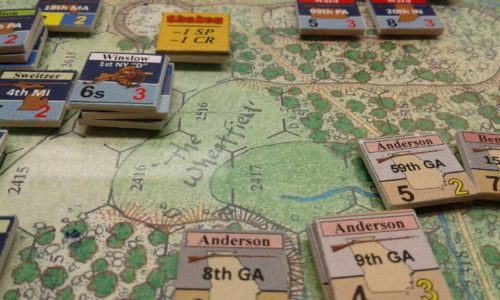
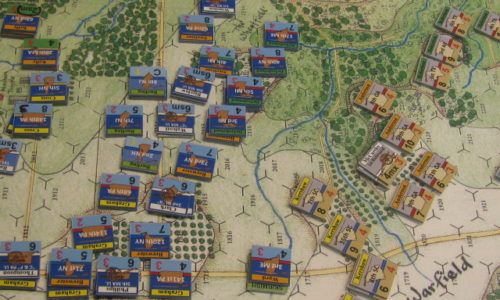
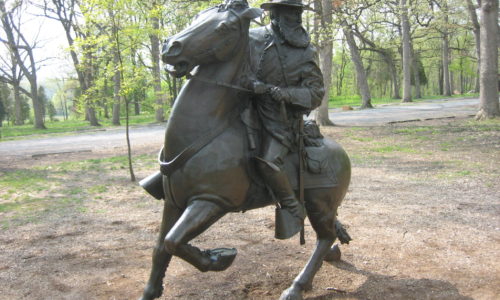
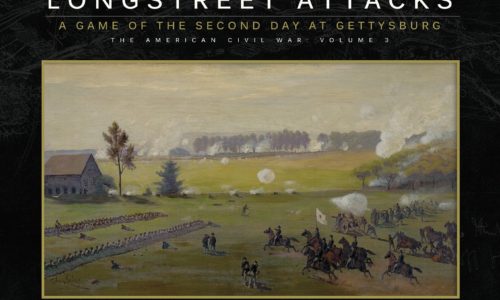
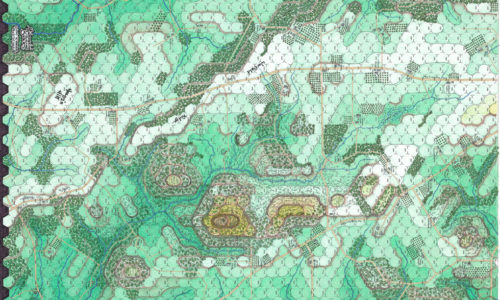
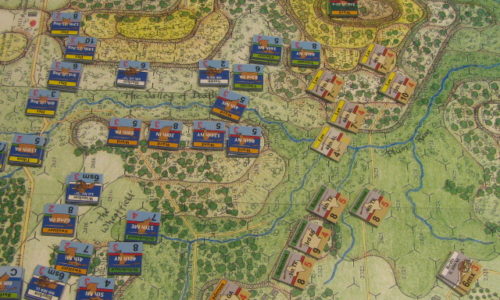
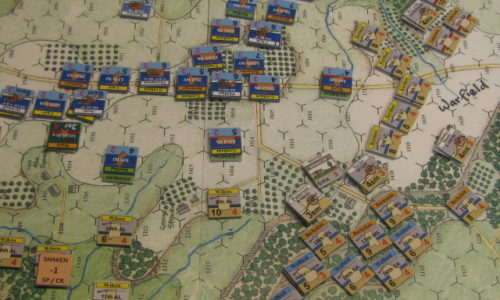
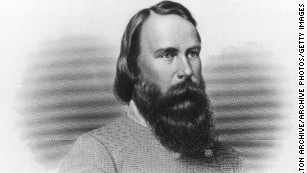
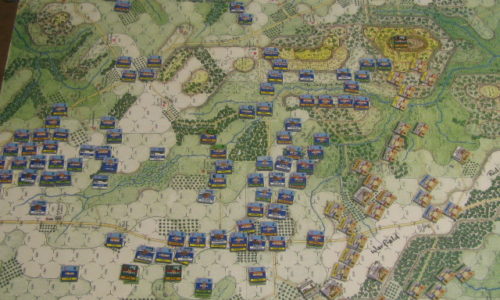
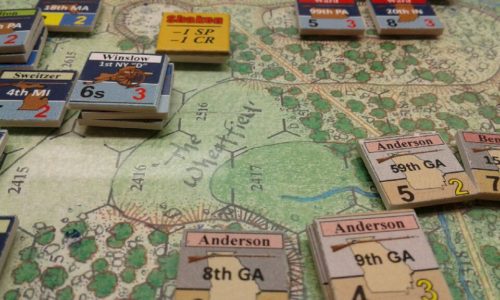
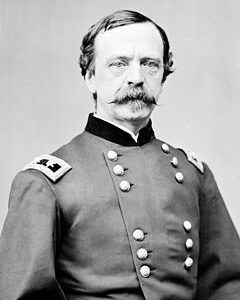
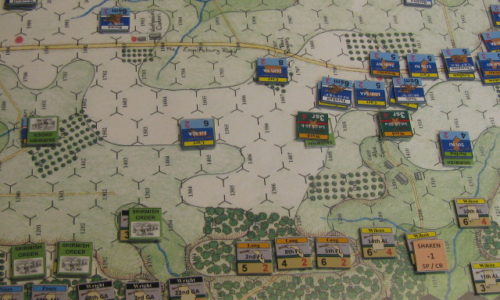
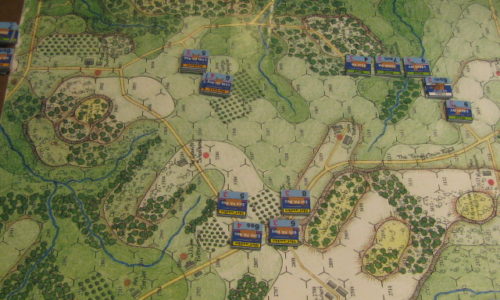
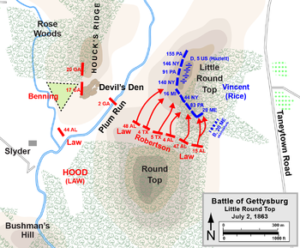
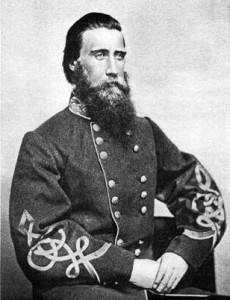






thanks for share your knowledge.cialis online